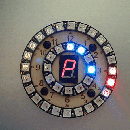Introduction: Pogo Pin Programming Connector
Pogo pins are spring-loaded conductive pins that are good for making temporary electrical connections. They are often used for testing electrical signals on printed circuit boards.
I recently had a project where I needed to make 400 identical circuit boards. Each had an ATtiny microcontroller that required programming. Using a clip-on programmer seemed like the best way to get all of the boards programmed. This particular microcontroller requires 6 electrical connections to program it using an Arduino as the programmer (see this instructable for details). I added 6 rectangular test points for these signals on one edge of the circuit board with the proper .1" spacing between them.
This instructable shows how I made the clip-on connector.
Parts:
Step 1: Proto Board
Cut a section of stripboard proto board to size with a jig saw, and sand the edges. My project needs 6 connectors, so I am using a section with 6 rows with 8 holes on each row. That gives a good size of about .6" x .8" that fits my spring clip well. In the picture above there are two cut sections, to allow for mistakes along the way.
Step 2: Solder the Pogo Pins
Press the pogo pins through the holes at the end of each row of the circuit board and solder in place. You should hand fit the board on top of the clip to make sure that the pins are in a good place to make contact with the board to be programmed. The pins should be positioned such that they spring compress a little bit when the clip is holding a board to be programmed.
Step 3: Attach the Wires
For my project, the connections when facing the board edge are in order:
GND, PB0. PB1, PB2, Reset, and Vcc.
I chose to use corresponding jumper wires in the order of:
black, blue, green, yellow, orange, and red.
Place the end of the first wire in a hole with enough of the pin protruding so that it can be bent it flat against the board after soldering. Solder in place. Continue with the rest of the wires all of the way across. Then carefully bend the wires flat against the edge of the board.
Step 4: Shrink Tubing (optional)
If you wish, add an appropriate piece of shrink tubing over the stripboard and wire ends. Using a heat gun (hair dryer can work), heat the tubing until it shrinks around the board and wires.
Step 5: Attach the Clip
Use a hot glue gun to attach the board to the end of the clip in the appropriate place. Hold it there until the glue sets. Then use one or two small zip ties to firmly secure it.
Step 6: Testing It Out
The pogo programming clip is complete! Try it out by clipping it onto your board and programming the board with it.
Again, for my project, the device to be programmed is the ATtiny85 microcontroller. Testing this requires connecting the other end of the 6 jumper wires to the appropriate holes of an Arduino as outlined in this instructable.
Here's a link to the particular board for which this pogo clip is intended. The connection points are on the bottom side of the board (Click "layers" and "bottom" to see them).





